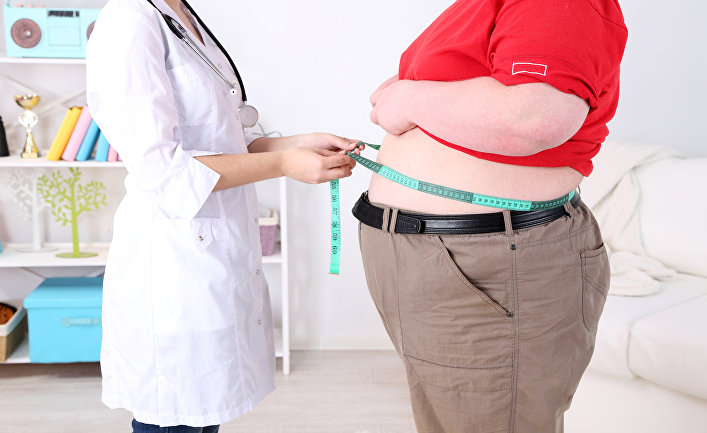
The AspireAssist device could be the most convenient way of treating obesity. It works as a probe for artificial feeding, only in the opposite direction: with the help of an endoscope and a tiny blade, the doctor puts into the stomach inner catheter and excretes it through the skin. After this, the patient wakes up and goes home implanted in the stomach of a round plastic valve. Over the next few months in about 20 minutes after each meal, the patient connects the drain with the valve and drains a significant part of stomach contents directly into the toilet.
This intervention is the latest in a series of minimally invasive equipment, approved by Management on sanitary inspection behind quality of foodstuff and medicines USA (FDA) for the treatment of obesity. Her supporters refer to the absence of arguments against the fact that “aspiration therapy” helps people to lose weight. Critics say about your disgust and claim that it’s just a way to surgically trigger an eating disorder. The reasons for dissatisfaction among both professionals and bystanders range from accompanied by eye-rolling comments to full of indignation. Thanks to the directness of his method is a new strategy of treatment he showed a lot of disgusting, foolish and dangerously reckless.
These objections confirmed in a radically false idea of obesity as a biological process. Indeed, an active concern about what is morally acceptable intervention, speaks of stubborn assumptions of the “weight reflects the character of a man.” AspireAssist focuses on ongoing tensions between two opposing concepts: obesity as a multifactorial epidemic and obesity as a lack of willpower. The conscious approval of the first often masks an instinctive adherence to the second, leaving unresolved the issue and its causes.
Globally, the growth in the number of obese people has become particularly noticeable since the mid-20th century, and explain it will help a few significant cultural forces. It all started with industrialization, which contributed to a sedentary lifestyle and the growing abundance of energy-dense foods. Among the factors that influenced the variety of types of obesity in the regions were reviewed and more specific socio-political conditions such as income inequality, the priorities of investment in agriculture and the recent ubiquity subjected to intensive processing products. These forces are opposed by the metabolic tendencies, which over the millennia have evolved in very different terms — namely, in conditions of relative scarcity, when people ate at every opportunity. Recent research in the field of human physiology has provided an extensive insight into the complexity of the system, its variability and vulnerability.
Growing problem of weight gain supported the “medicalization of obesity” — its perception as a disease that must be addressed by health workers in institutions. This concept, in turn, led to the development of a whole set of methods of treatment of obesity in addition to the typically recommended diet and exercise. Today there are many prescription drugs for weight loss. And bariatric surgery, which is to reduce stomach volume or shortening part of the small intestine appeared a few decades ago and has become the most common due to improved technical equipment and better treatment outcomes.
Nevertheless, no miracle cures in the fight against excess weight transpired: diet and drugs bring mostly modest and temporary results, and surgical intervention is not only quite expensive, but also fraught with complications. Therefore, any alternative options, more aggressive than diet, but less invasive than surgery. Here are devices that are placed inside the stomach and create a feeling of satiety, gastric resection to reduce the absorption of food, and, of course, the AspireAssist device. They are based on an understanding of obesity as a mechanical problem requiring a mechanical solution.
In the era turned into the disease of obesity is still relevant moral side of the question with regards to excess weight. The tendency to be overweight is a stigma, despite its growing prevalence. Fighting with being overweight weight even when successful, is the basis for judgments about personal qualities of the person. Research in the field of sociology, for example, show that patients who resort to the help of bariatric surgery, are considered to be more lazy and less authoritative than sitting on a diet and going in for sports. Due to its simplicity the device AspireAssist has helped to highlight these outdated prejudices and provided a good opportunity for their detailed study.
Emerging on aesthetic grounds objections AspireAssist appeared on quite General grounds, as evidenced by headlines calling him “disgusting.” Use the AspireAssist violates the natural boundaries of the body, rather unceremoniously revealing its inner workings to the world. The mental image of chyme —polupereprevshego stomach contents — may be instinctively unpleasant as the sight of vomit or excrement. Other artificial flaunting of stomach contents in this type of intervention seems unequivocally annoying.
In these expressions of physical disgust hidden in less obvious, but no less significant element of moral disgust. A good example is one of the leading late-night talk show Stephen Colbert who said that “many patients so adore your vomit implanted devices that want to keep them forever.” This episode plays on the disgust of the audience, describing the reception of calories as a happy event, therefore the obesity is exposed in an unfavorable light indulgence.
Other critics consider the treatment of the deliberate destruction of food equivalent to “medically approved bulimia”. The AspireAssist device was, as far as I know, the only FDA-approved bariatric intervention, in which online discussions are preceded by a warning about possible adverse reaction. The mode of action of the device considered dangerous enough from the point of view of stress caused by just one description, among patients with eating disorders, and among the already cured patients. Confusion of bulimia and obesity, however, weakens the seriousness of each of them separately. This criticism implicitly portrays overweight as a separate eating disorder and creates a fundamentally wrong understanding of how obesity occurs and why it is so difficult to get rid of.
 © Fotolia, Africa StudioПациент overweight
© Fotolia, Africa StudioПациент overweight
A number of studies of the biological causes of obesity continues to increase rapidly. The fact that in spite of the amount of data we continue to ask basic questions about the mechanism of development of this disease, indicates a high degree of complexity of the problem. To downplay the significance of this multifactorial disease to talking about weak-willed behavior — then present it in a distorted way.
When I in 2007 started medical school about body weight, we were told from the point of view of simple thermodynamics: the change in weight equals caloric intake minus caloric expenditure. Modern research, however, are paying increasing attention to many different intermediate stages in the process of obesity, taking for granted the fact that consumption and the energy consumption differ from person to person. Due to concerns that AspireAssist may reduce the importance of personal responsibility in the fight against obesity, should take into account many predisposing factors that exist outside of personal control.
Involved variables are divided into two main categories: the “homeostatic” and “hedonic”. The homeostatic risk factors relate to the metabolic physiology — the various ways in which the body itself supports. These risk factors have been identified in almost all levels of biological organization. Extensive genome-wide studies have identified several genes that may predispose people to weight gain. Tests on animals showed that certain nutritional risks in the development process can influence how genes are expressed early in life and as a result how in the future deposited calories. From the point of view of the internal organs, it is considered that overweight people may have certain irregularities in their innards, such as, for example, the tendency to delay the flow of digested food from the stomach into the small intestine. The risk can also depend on the intestinal microflora and the interaction between the bacteria within the digestive tract; at least there is one case of rapid and unexpected weight gain in women after treatment, fecal transplantation from a donor with excess weight.
The hedonic variables, on the other hand, represent the environmental stimuli, such as the levels of tension and taste of food, and psychological risk factors, such as mood, body scheme and views about medicine. In addition to affecting weight gain hedonic factors requires an honest assessment for the recognition of their profound relationship with the physiological sphere. Stress, for example, can affect gene expression.
Unit removes one-third of each meal: this is a clear absence of therapeutic causes of delicacy indelicate ways of presenting the problems of obesity.
At the intersection of the homeostatic and hedonic States, there are two especially important: hunger (urge to eat) and satiation (feeling of fullness). These studies describe these States as the product of complex neurochemical mechanism is adjusted by the conditioned cognition during the first years of life and controlled the unstable hormonal background. Thus, although it may involve representatives of separate homeostatic and hedonic subtype of obesity, these two categories of risk are often intertwined in reality.
AspireAssist could undermine our perception of the complexity of this process. It seems that the device, which removes about a third of the calories of each meal, working on the same basic thermodynamic arithmetic, which I encountered once enrolled in medical school. This is a clear absence of therapeutic causes of delicacy indelicate ways of presenting the problems of obesity.
Some critics fear, for example, that only one AspireAssist to change behavior is not enough. Artificial getting rid of food without losing its taste, as they say, is ineffective as a long-term weight loss strategy. A recent article on aspiration therapy in the “British medical journal” refers to the questionable stories of the last years of the Roman Empire, when the decline of morals was allegedly so widespread that evoking the gag reflex has become a common way to survive a multi-day feast. To the extent in which this reference corresponds to the long look at obesity, the AspireAssist only adds fuel to the fire.
Testers of the device to this criticism reacted, although this is often do not attach importance to. A recent preliminary study showed that patterns of compulsive overeating in the course of the experiment arose. In General, had reason to believe that there were only positive changes in behavior. After careful counting of calories contained in the test meals and the gastric aspirate, it was found that gastric lavage had only 80 per cent of the observed weight loss. The research team suggested that the device contributed to the slower chewing food, increased water consumption and more structured diet, which leads to extra calorie restriction.
Still have to research in the field of safety and effectiveness, however, is that the device appears to be competitive along with other minimally invasive bariatric surgery. On an individual basis AspireAssist helps much more than hurts. For many outside observers a visual image of aspiration therapy remains inexcusable disgusting. But we come to understanding how society is biased against overweight people, and should become more open to effective treatment.
Overall, the value of expanding the set of methods of treatment of obesity stems from the fact that certain patients will definitely respond well to certain treatments. A special combination of intensity and of homeostatic and hedonic risk factors will vary, as for example, what at first glance looks like one and the same disease that likely represents a variety of different ways to a common physical manifestation. Biological way each patient to obesity, leads in turn to a specific set of therapeutic goals that may include, for example, neurohormonal dysfunction in one case, the imbalance of microorganisms in the other and affective disorder in the third.
This concept is consistent with our growing attention to personalized medicine, optimizing procedures by adapting them to the individual characteristics of a person. This ensures a particularly reasoned basis for considerations regarding the treatment of excess weight, which suggests that the approved operational measures alone or in combination with each other, can be used more accurate methods.
 © RIA Novosti, Inna of Pinacoladas at the Moscow gastronomic festival
© RIA Novosti, Inna of Pinacoladas at the Moscow gastronomic festival
This model necessarily involves the AspireAssist device, no matter how ill-conceived did not seem his action. Before assigning aspiration therapy, physicians should closely monitor the possibility of addiction to compulsive overeating in the course of using this device at all, except the most susceptible patients. At the same time, the probability of the intersection of obesity and eating disorders does not mean that it always happens. The joint manifestation of these two processes in a small number of cases does not exclude the potential benefits of the device in most of the rest.
The device will help to circumvent the usual struggle for a healthy weight involuntary processes.
AspireAssist is just one of many minimally invasive treatment of obesity among recent or active development. The FDA has recently approved two projects elastic intragastric balloons designed to limit the calorie intake for a few months. For implantation in the small intestine using special sleeves that prevent the absorption passes through its tissues nutrients. There is still electrical stimulator called “Maestro”, which is implanted surgically to influence the vagus nerve, a direct channel of communication between the gut and the brain (a bit unclear exactly how these impulses help to fight obesity, but the working hypothesis suggests the intervention in the mechanism of occurrence of feeling of hunger). In some centres, to reduce suction, intentionally removed stomach tissue.
As AspireAssist those are mechanical restrictions, Fiziologiya digestion. Judging by the number of comments that these other interventions did not represent special problems in the context of aesthetic or moral receptivity. And aspiration therapy, by contrast, openly associates the process of eating with trips to the bathroom. Among the mentioned here are alternative options only this device is partially outside the body; and it only requires regular manual manipulation, making the treatment especially visible and active in the process.
In principle, the aspiration of the treatment equals the treatment of excess weight to prolonged disruption of physiological processes. It breaks the fat body in the wrong direction — bodily changes occur without additional load on the brain. Where nausea, sweat, sacrifice? Where hard constraints where the pain is? Devices like AspireAssist will help to circumvent the usual struggle for a healthy weight involuntary processes.
In the design of the AspireAssist, there are reasonable limits, though not immediately noticeable. The kit includes a counter 115, a suction manipulation, which then must be reset oleasea doctor. Controlled use of the device in the long run contributes to the delicate restructuring thinking and behavior, careful adjustment of the set of metabolic and motivational variables. By assumption, the author of the experimental study Shelby Sullivan, one of the therapeutic properties of this device can be the visibility of his actions: view leaving the body partially digested food can contribute to a more careful approach to diet.
I must admit that like a more honest explanation of the action AspireAssist is exactly what I hope the producers. It reflects the very essence of advertising devices to help the patient as a mediator rather than seek the easy way, plus the term “aspiration” with its double meaning of desire to go forward and delete the contents of the stomach. More cynical critics of this method noticed that the owner of the corresponding patent of Dean Kamen has also developed electric scooters Segway (Segway), and compare it has two main objectives. First, to draw attention to the commercial motivations AspireAssist, challenging its medicinal properties and define it as a fruit market forces. Second, the attempt to christen both factors promote idleness, to avoid physical labor.
None of this seems to me very convincing. Prepared financial incentives bariatric medicine, which should be obvious to even the most casual observers are responsible for constant innovation in his field. There is an abundance of mechanical interventions in the process of losing weight, and they are all aimed at using a large number of patients for whom measures to maintain a healthy lifestyle. Sorting all of these treatment options in accordance with their advantages confirms the older system of values, which misses the point.
If the AspireAssist device will continue to offend people with his progressive courage and artificiality, we could also think of all the artificial elements of the modern obesity epidemic and gave rise to its cultural environment. Genuine commitment to health and well-being implies a willingness to effective treatments, even if at first glance they seem out of place.
Nitin Ahuja is a gastroenterologist at Johns Hopkins University in Maryland. The degree of doctor of medicine received from the University of Michigan. Resides in Baltimore.







